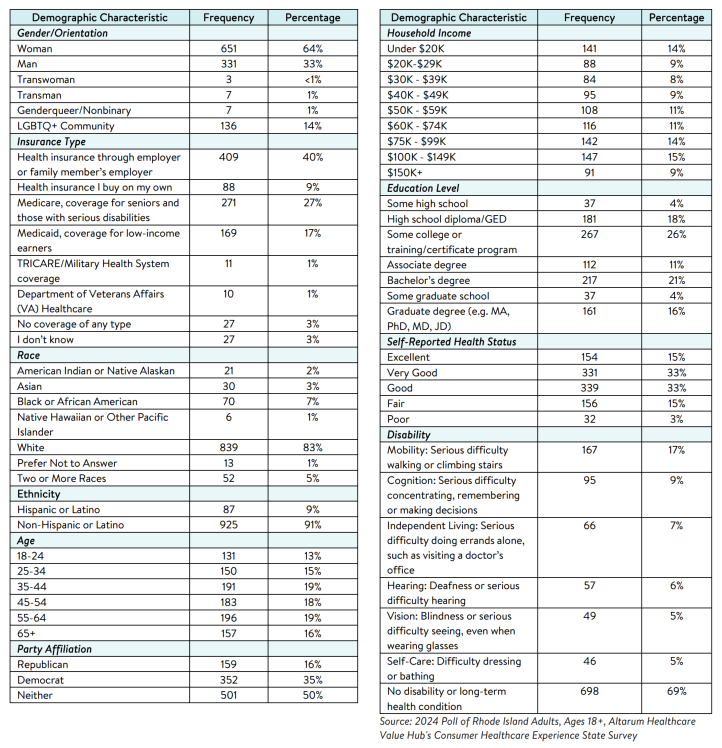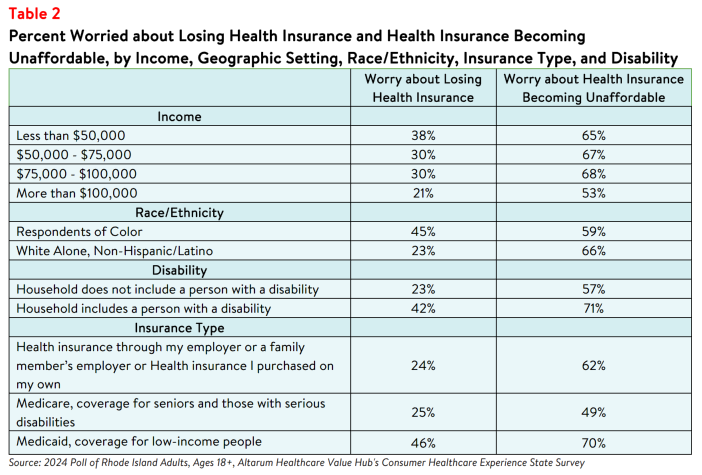Rhode Island Survey Respondents Struggle to Afford High Health Care Costs; Worry about Affording Health Care in the Future; Support Government Action Across Party Lines
Key Findings
A survey of more than 1,000 Rhode Island adults, conducted from February 19 to March 27, 2024,
found that:
- Over 3 in 5 (69%) experienced at least one health care affordability burden in the past year;
- Over 4 in 5 (82%) worry about affording health care in the future;
- Over 3 in 5 (66%) of all respondents delayed or went without health care due to cost in the last twelve months;
- Low-income respondents and those with disabilities had higher rates of going without care due to cost and incurring medical debt, depleting savings, and/or sacrificing basic needs due to medical bills; and
- Across party lines, respondents express strong support for government-led solutions.
A Range of Health Care Affordability Burdens
Like many Americans, Rhode Island adults experience hardship due to high health care costs. Overall,
nearly seven out of ten (69%) respondents experienced one or more of the following health care
affordability burdens in the prior 12 months:
1) Being Uninsured Due to High Costs
Nearly half (45%) of uninsured respondents cited “too expensive” as the main reason for not having health insurance, far exceeding other reasons like “don’t need it” and “don’t know how to get it.” In addition, 51% of respondents without dental insurance cited cost as the main reason for not having coverage, and 38% those without vision insurance cited cost as the main reason for not having coverage.
2) Delaying or Going Without Health Care Due to Cost
Well over half (66%) of all respondents reported delaying or going without health care during the prior 12
months due to cost:
- 25%—Skipped needed dental care
- 24%—Cut pills in half, skipped doses of medicine or did not fill a prescription1
- 22%—Skipped a recommended medical test or treatment
- 17%—Had problems getting mental health care or addiction treatment2
- 21%—Delayed going to the doctor or having a procedure done
- 11%—Avoided going to the doctor or having a procedure done altogether
- 11%—Skipped needed vision services
- 6%—Skipped or delayed getting a medical assistive device
- 5%—Skipped needed hearing services
Respondents most frequently cited not being able to get an appointment as the reason for them or their
family members not getting care in the last year (24%), followed by cost (17%), exceeding a host of other
barriers like getting time off work, transportation, and lack of childcare.
3) Struggling to Pay Medical Bills
Other times, respondents got the care they needed but struggled to pay the resulting bill. Over one-third
(33%) of respondents reported experiencing one or more of these struggles to pay their medical bills:
- 13%—Were contacted by a collection agency
- 12%—Used up all or most of their savings
- 10%—Were unable to pay for basic necessities like food, heat or housing
- 8%—Racked up large amounts of credit card debt
- 8%—Borrowed money, got a loan or another mortgage on their home
- 6%—Were placed on a long-term payment plan
- 4% - Asked for donations (GoFundMe campaigns)
High Levels of Worry About Affording Health Care in the Future
Rhode Island respondents also exhibit high levels of worry about affording health care in the future. Over
four in five (82%) reported being “worried” or “very worried” about affording some aspect of health care
in the future, including:
- 68%—Cost of nursing home or home care services
- 66%—Medical costs when elderly
- 61%—Health insurance will become unaffordable
- 60%—Medical costs in the event of a serious illness or accident
- 53%—Prescription drugs will become unaffordable
- 52%—Cost of dental care
- 45%—Cost of needed vision services
- 43%—Cost of needed hearing services
While two of the most common worries—affording the cost of nursing home or home care services and
medical costs when elderly—are applicable predominantly to an older population, they were most
frequently reported by younger respondents. Respondents ages 18-54 reporting higher worries of paying
for medical costs when elderly and respondents ages 25-64 report higher worries of affording the cost of
a nursing home or home care services. This finding suggests that Rhode Island respondents may be
worried about affording the cost of care for both aging relatives in addition to themselves.
Worry about affording health care was highest among respondents living in low-income households, and
among those living in households with a person with a disability (see Table 1). Overall, 87% of respondents with household incomes less than $75,000 a year reported worrying about affording some aspect of coverage or care in the past year, however 74% of those earning over $100,000 per year were also worried.3 Most Rhode Island respondents of all incomes, races, ethnicities, and levels of ability were
somewhat or very concerned.
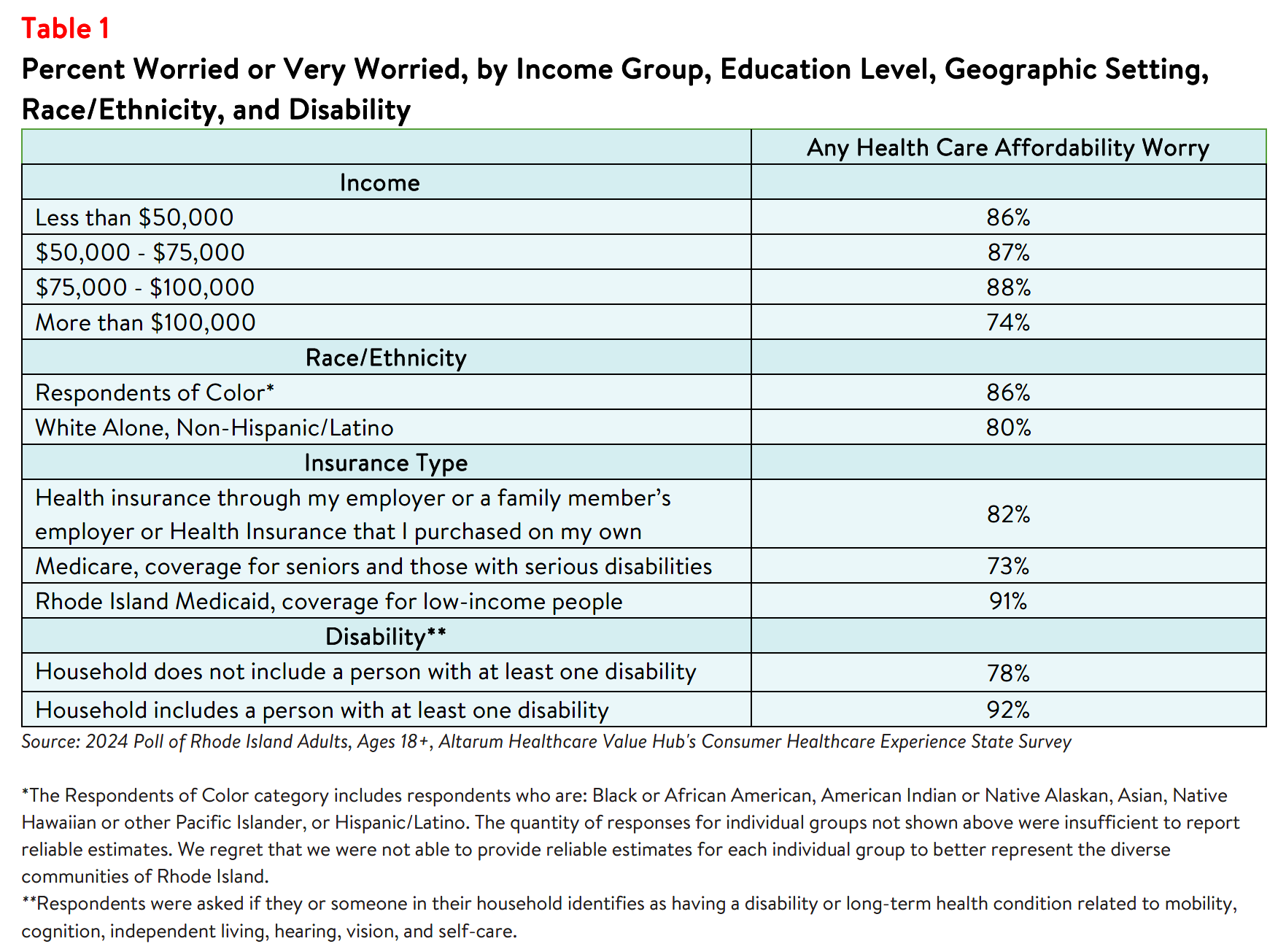
Concern that health insurance will become unaffordable is also more prevalent among certain groups of
Rhode Island respondents. By insurance type, respondents with Medicaid coverage, most frequently
reported worrying about affording coverage, followed by respondents with coverage through their
employer and those with coverage purchased on their own (see Figure 1).

Respondents with household incomes below $50,000 per year reported the highest rates of worry about
losing coverage, while those earning $75,000 to $100,000 reported the highest rates of worrying about
not being able to afford coverage in the future (see Table 2). Respondents living in households with a
person with a disability reported higher rates of being concerned about losing health insurance than those
living in a household without a person with a disability. Concerns about affording coverage exceeded fears about losing coverage across all income groups, disability statuses, geographic settings, races/ethnicities, and coverage types.
Differences in Health Care Affordability Burdens
The survey also revealed differences in how Rhode Island respondents experience health care affordability burdens by income, age, geographic setting, race/ethnicity, and disability.
Income and Age
Unsurprisingly, respondents at the lowest end of the income spectrum most frequently reported
experiencing one or more health care affordability burdens, almost four out of five (79%) of those earning
less than $50,000 per year reporting struggling to afford some aspect of coverage or care in the past 12
months (see Figure 2). This may be due, in part, to respondents in this income group reporting higher rates of going without care and rationing their medication due to cost (see Figure 3).
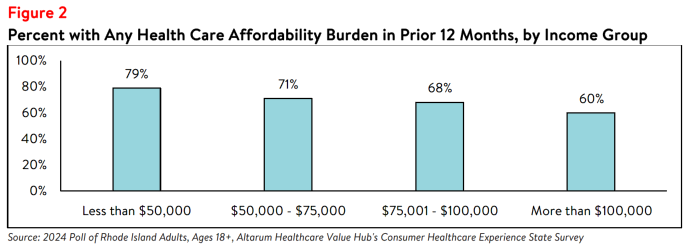

Further analysis found that Rhode Island respondents ages 18-44 reported higher rates of going without
care due to cost than respondents ages 45 and older (see Figure 4). Respondents ages 18-44 also most
frequently reported rationing medication due to cost compared to other age groups.
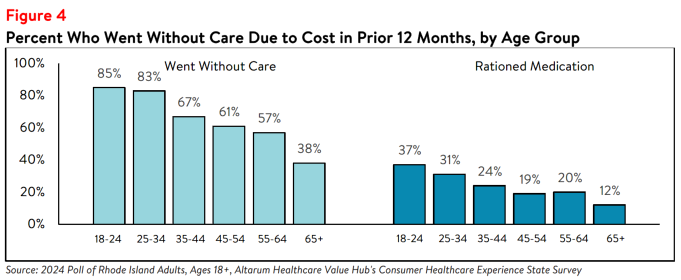
Disability
Respondents living in households with a person with a disability reported the highest rates of going
without care and rationing medication due to cost in the past 12 months. Almost eight in ten (78% of)
respondents in this group reported going without some form of care and 31% reported rationing
medication, compared to 62% and 21% of respondents living in households without a person with a
disability, respectively (see Table 4). Respondents living in households with a person with a disability also
more frequently reported delaying or skipping getting mental health care, addiction treatment, and dental
care, among other health care services, than those in households without a person with a disability due to
cost concerns (see Table 3).
Those with disabilities also face health care affordability burdens unique to their disabilities—12% of
respondents with a disabled household member reported delaying getting a medical assistive device such
as a wheelchair, cane/walker, hearing aid, or prosthetic limb due to cost. Just 4% of respondents without a
person with a disability in their household (who may have needed such tools temporarily or may not
identify as having a disability) reported this experience.
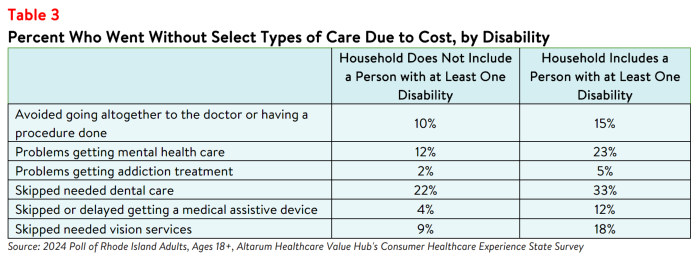
Insurance Type
Respondents with Rhode Island Medicaid coverage reported the highest rates of going without care due
to cost and rationing medication, followed by respondents with private insurance purchased
independently (see Table 4). Still, over half (55%) of respondents with Medicare coverage also went
without care due to cost in the twelve months prior to taking the survey.
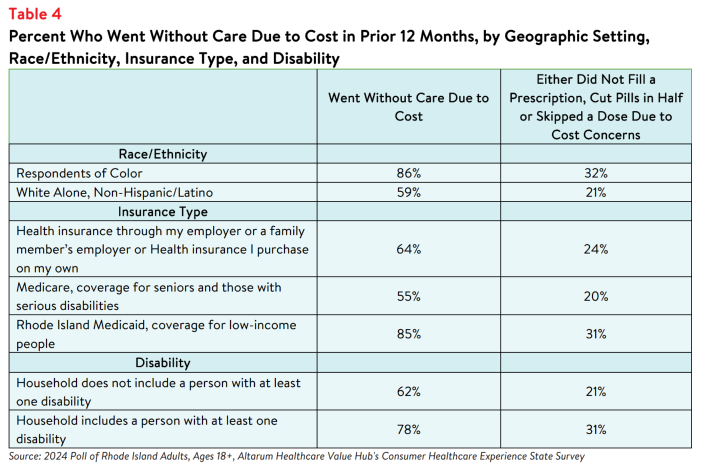
Survey respondents also had the opportunity to share their own stories about going without care due to
cost in the past year. Notably, respondents with both private insurance and Medicaid coverage reported
challenges affording care (see Table 5).
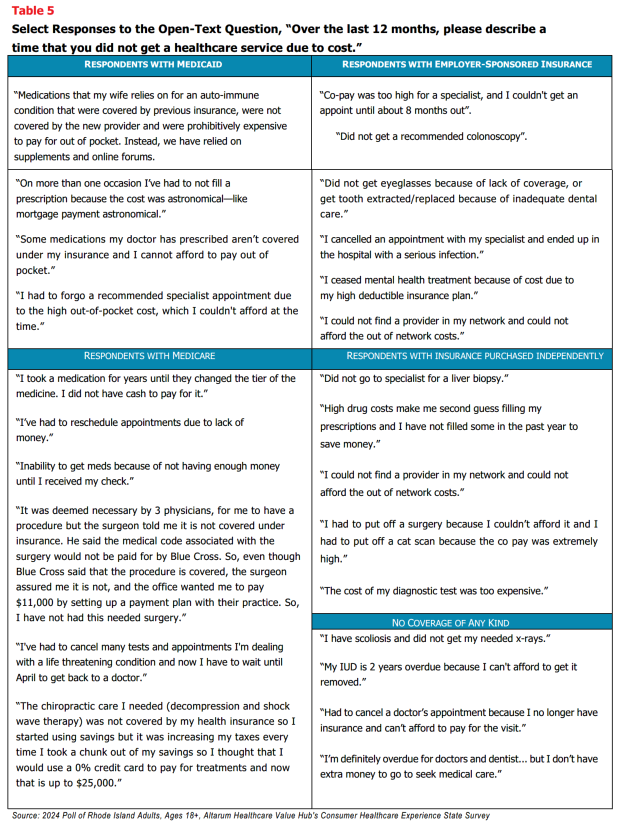
Race and Ethnicity
Rhode Island respondents of color reported higher rates of rationing medication and forgoing care than
white alone, non-Hispanic/Latino respondents. Over eighty percent (86%) of respondents of color
reported going without care due to cost in the past twelve months compared to 59% of white alone, non-
Hispanic/Latino respondent (see Table 4). Further analysis showed that respondents of color also reported higher rates of challenges receiving mental health care and skipping needed dental care (see Figure 5).
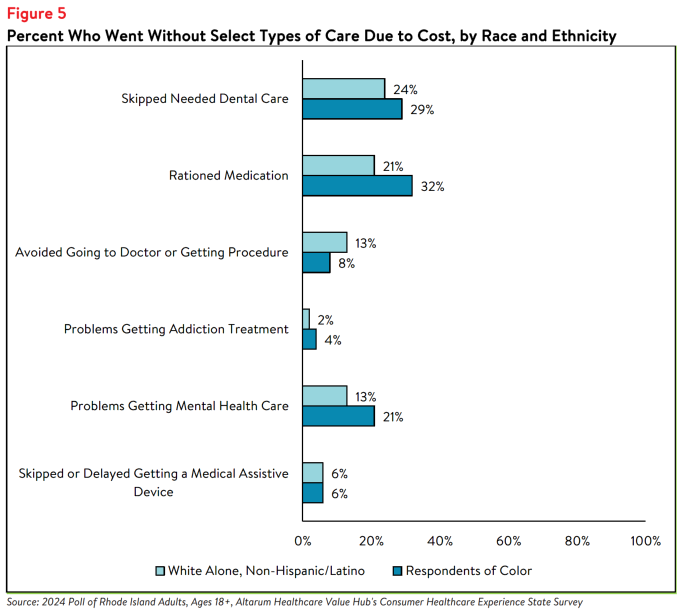
Encountering Medical Debt
The survey also showed differences in the prevalence of financial burdens due to medical bills, including
going into medical debt, depleting savings, and being unable to pay for basic necessities (like food, heat,
and housing) by income, race, ethnicity, disability status, and geographic setting. Forty six percent
respondents of color reported going into debt, depleting savings, or going without other needs due to
medical bills, compared to 28% of white alone, non-Hispanic/Latino respondents (see Table 6).
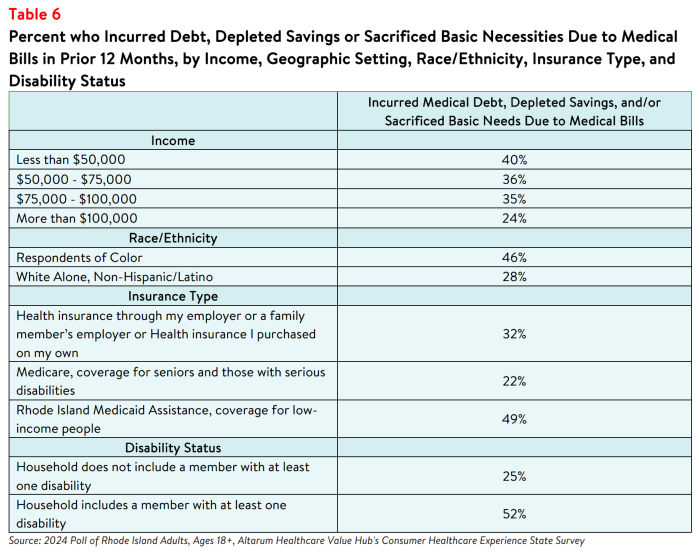
The rate of financial burden is even higher for respondents who have or live with a person with a disability,
with over one-half (52%) reporting going into debt or going without other needs due to medical bills,
compared to 25% of respondents without a disabled household member. In addition, respondents with
Medicaid coverage reported the highest rate of the above financial burdens due to medical bills (49%)
compared to respondents with all other insurance types.
Dissatisfaction with the Health System and Support for Change
In light of Rhode Island respondents’ health care affordability burdens and concerns, it is not surprising
that they are dissatisfied with the health system:
- Just 26% agreed or strongly agreed that “we have a great healthcare system in the U.S.,”
- While 75% agreed or strongly agreed that “the system needs to change."
To investigate further, the survey asked about both personal and governmental actions to address health
system problems.
Personal Actions
Rhode Island respondents see a role for themselves in addressing health care affordability. When asked
about specific actions they could take:
- 54% of respondents reported researching the cost of a drug beforehand, and
- 74% said they would be willing to switch from a brand name to an equivalent generic drug if given the chance.
When asked to select the top three personal actions they felt would be most effective in
addressing health care affordability (out of ten options), the most common responses were:
- 67%—Take better care of my personal health
- 35%—Research treatments myself before going to the doctor
- 31%—Do more to compare doctors on cost and quality before getting services
- 29%—Write to or call my state representative asking them to take action on high health care prices and lack of affordable coverage options
- 27%—There is not anything I can do personally to make our health system better
Government Actions
But far and away, Rhode Island respondents see government as the key stakeholder that needs to act to
address health system problems. Moreover, addressing health care problems is one of the top priorities
that respondents want their elected officials to work on.
At the beginning of the survey, respondents were asked what issues the government should address in the upcoming year. The top vote getters were:
- 49%—Health care
- 46%—Affordable Housing
- 44%—Economy/Joblessness
When asked about the top three health care priorities the government should work on, the top vote getters were:
- 53%—Address high health care costs, including prescription drugs
- 35%—Preserve consumer protections preventing people from being denied coverage or charged more for having a pre-existing medical condition
- 32%—Get health insurance to those who cannot afford coverage
- 32%—Improve Medicare, coverage for seniors and those with serious disabilities
Of 15 options, Rhode Island respondents believe the reason for high health care costs is unfair prices
charged by powerful industry stakeholders:
- 79%—Drug companies charging too much money
- 74%—Insurance companies charging too much money
- 72%—Hospitals charging too much money
When it comes to tackling costs, respondents endorsed a number of strategies, including:
- 91%—Show what a fair price would be for specific procedures
- 91%—Require insurers to provide up-front cost estimates to consumers
- 90%—Cap out-of-pocket costs for life-saving medications, such as insulin
- 92%—Require drug companies to provide advanced notice of price increases and information to justify those increases
- 91%—Require hospitals and doctors to provide up-front cost estimates to consumers
- 89%—Make it easy to switch insurers if a health plan drops your doctor
- 90%—Set standard prices for drugs to make them affordable
- 90% - Authorize the Attorney General to take legal action to prevent price gouging or unfair prescription drug price hikes
Support for Action Across Party Lines
There is also remarkable support for change regardless of respondents' political affiliation (see Table 7).
The high burden of health care affordability, along with high levels of support for change, suggest that
elected leaders and other stakeholders need to make addressing this consumer burden a top priority.
Moreover, the COVID crisis has led state residents to take a hard look at how well health systems are
working for them, with strong support for a wide variety of actions. Annual surveys can help
assess whether progress is being made.
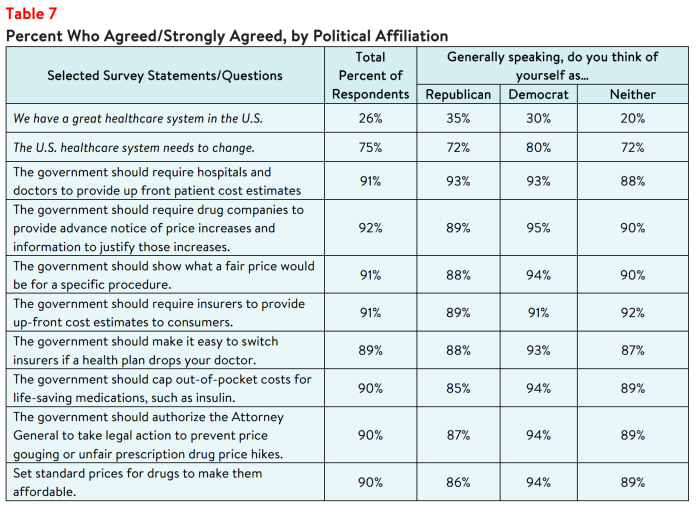
Notes
- Twenty percent (20%) did not fill a prescription and 9% cut pills in half or skipped doses of medicine due to cost.
- Fifteen percent (15%) had problems getting mental health care and 3% had problems getting addiction treatment.
- Median household income in Rhode Island was $81,370 (2018-2022). U.S. Census, Quick Facts. Retrieved from: U.S. Census Bureau QuickFacts, U.S. Census Bureau QuickFacts: Rhode Island.
Methodology
Altarum’s Consumer Healthcare Experience State Survey (CHESS) is designed to elicit respondents’ views on a wide range of health system issues, including confidence using the health system, financial burden and possible policy solutions. This survey, conducted from February 19 to March 27, 2024, used a web panel from Dynata with a demographically balanced sample of approximately 1,100 respondents who live in Rhode Island. Information about Dynata’s recruitment and compensation methods can be found here. The survey was conducted in English or Spanish and restricted to adults ages 18 and older. Respondents who finished the survey in less than half the median time were excluded from the final sample, leaving 1,012 cases for analysis. After those exclusions, the demographic composition of respondents was as follows, although not all demographic information has complete response rates:
